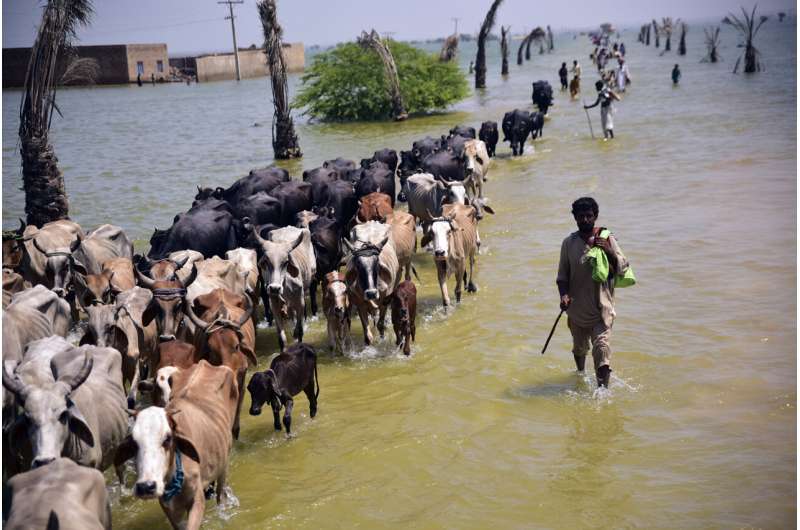Warming causes more extreme rain, not snow, over mountains and scientists say that’s a problem

A warming world is transforming some major snowfalls into extreme rain over mountains instead, somehow worsening both dangerous flooding like the type that devastated Pakistan last year as well as long-term water shortages, a new study found.
Using rain and snow measurements since 1950 and computer simulations for future climate, scientists calculated that for every degree Fahrenheit the world warms, extreme rainfall at higher elevation increases by 8.3% (15% for every degree Celsius), according to a study in Wednesday’s journal Nature.
Heavy rain in mountains causes a lot more problems than big snow, including flooding, landslides and erosion, scientists said. And the rain isn’t conveniently stored away like snowpack that can recharge reservoirs in spring and summer.
“It is not just a far-off problem that is projected to occur in the future, but the data is actually telling us that it’s already happening and we see that in the data over the past few decades,” said lead author Mohammed Ombadi, a Lawrence Berkeley National Laboratory hydrologist and climate scientist.
As the world has warmed to the brink of the 1.5 degree Celsius (2.7 degrees Fahrenheit) internationally agreed threshold to stem the worst effects of climate change, this study shows “every degree (Celsius) matters because it comes with an additional 15% increase” in extreme rain over mountains, Ombadi said. That per-degree rainfall boost in the mountains is more than twice the increase the rest of the world gets from warming air holding more water.
The study looked at only the heaviest rains each year over six decades in the Northern Hemisphere, finding that as altitude rose, so did the turbocharging of rain. The biggest increase in rains were noticed at about 10,000 feet (3,000 meters). That includes much of the American West, where Ombadi said “it’s very pronounced,” as well as parts of the Appalachian Mountains. Another big hotspot in Asia is the Himalayas, Tian Shan and Hindu Kush mountains, with the Alps also affected.
About one in four people on Earth live in an area close enough to the mountains or downhill that extreme rain and flooding would hit them, Ombadi said.
It means more of the type of flooding off the mountains like the one that killed more than 1,700 people in Pakistan and put one-third of the country underwater, Ombadi said. But he noted that they haven’t studied Pakistan’s 2022 floods precisely so there may be some small differences.
The study makes sense and “the implications are serious,” said UCLA climate hydrologist Park Williams, who wasn’t part of the research. Scientists expect more precipitation with warmer temperatures, but heavy snow’s flooding impact is lessened because it takes time to melt and it’s easier to monitor snowpack to see what’s happening, he said.
“But as the proportion of mountain precipitation falling as snow decreases, flood hazards may enhance especially rapidly,” Williams said.
In the American West it hits hard in different ways, said study co-author Charuleka Varadharajan, a hydrologist.
“This kind of extreme rainfall is going to make the floods worse. And then you’ve got to figure out where is that water going?” she said, noting some of the flooding woes the West already dealt with this year in the wake of a series of atmospheric rivers and melting snowpack.
The flooding also can hurt food production, Ombadi said. He pointed to California Department of Agriculture estimates of $89 million in crop and livestock losses from torrential rains in 1997.
But in the long term, another problem is water supply. When the West gets heavy snowfall in the winter, that snow melts slowly in spring and summer, filling reservoirs where it can be useful when it’s needed later.
“It’s going to decrease your snow, your water supply in the future,” Varadharajan said. “You’re going to have more short-term runoff leading to more floods and less snowpack that recharges the groundwater and the groundwater is ultimately what helps maintain stream flows.”
“These mountainous systems are supplying most of the water in the West so any decreases in water supply would be pretty significant in terms of water management,” she said.
In times of drought—and much of the West is coping with a more than 20 year-long megadrought—water managers like to keep water levels high in reservoirs, which they can do with heavy snowpacks because it melts slowly, Williams said. But they can’t do that with heavy rainfall.
So as warming causes rainier extremes, society is going to have to choose between cutting water use because of low water levels in reservoirs to absorb a possible large sudden mountain runoff event or build expensive new reservoirs, Williams said.
___
Correction note: This story has corrected the mention of $89 million in crop and livestock losses due to heavy rains in California to 1997, not this year.
More information:
Mohammed Ombadi, A warming-induced reduction in snow fraction amplifies rainfall extremes, Nature (2023). DOI: 10.1038/s41586-023-06092-7. www.nature.com/articles/s41586-023-06092-7
© 2023 The Associated Press. All rights reserved. This material may not be published, broadcast, rewritten or redistributed without permission.
Citation:
Warming causes more extreme rain, not snow, over mountains and scientists say that’s a problem (2023, July 1)
retrieved 1 July 2023
from https://phys.org/news/2023-06-extreme-mountains-scientists-problem.html
This document is subject to copyright. Apart from any fair dealing for the purpose of private study or research, no
part may be reproduced without the written permission. The content is provided for information purposes only.
For all the latest Science News Click Here
For the latest news and updates, follow us on Google News.

